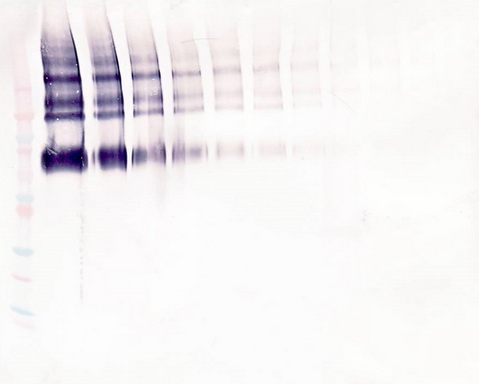Klotho Rabbit Polyclonal Antibody
Specifications
| Product Data | |
| Applications | ELISA, WB |
| Recommended Dilution | Direct ELISA: To detect Human Klotho by Direct ELISA (using 100μl/well antibody solution) a concentration of 0.25-1.0 μg/ml of this antibody is required. This biotinylated polyclonal antibody, in conjunction with compatible secondary reagents, allows the detection of at least 0.2-0.4 ng/well of recombinant Human Klotho. Sandwich ELISA: To detect Human Klotho by Sandwich ELISA (using 100μl/well antibody solution) a concentration of 0.25-1.0 μg/ml of this antibody is required. This biotinylated polyclonal antibody, in conjunction with purified anti-Klotho (Cat.-No AP32851BT-S or AP32851BT-N) as a Capture antibody, allows the detection of at least 0.2-0.4 ng/well of recombinant Human Klotho. Western Blot: To detect Human Klotho by Western Blot analysis this antibody can be used at a concentration of 0.1-0.2 µg/ml. Used in conjunction with compatible secondary reagents the detection limit for recombinant Human Klotho is 1.5-3.0 ng/lane, under either reducing or non-reducing conditions. |
| Reactivities | Human |
| Host | Rabbit |
| Clonality | Polyclonal |
| Immunogen | Highly pure (>98%) CHO cells derived recombinant Human Klotho (Cat.-No AR08005PU) |
| Specificity | This antibody recognizes Human Klotho. Other species not tested. |
| Formulation | PBS, pH 7.2 Label: Biotin State: Lyophilized (0.2µ Sterile filtered) purified protein |
| Reconstitution Method | Restore in sterile water to a concentration of 0.1-1.0 mg/ml. |
| Purification | Affinity Chromatography |
| Conjugation | Biotin |
| Background | Klotho is a glycosylated protein that plays an important role in the regulation of phosphate and calcium homeostasis. Human Klotho exists in both membrane bound and secreted forms, and is predominantly expressed in the kidney convoluted tubules, and to a lesser extent, in the brain, reproductive organs, endocrine glands, urinary bladder, skeletal muscle, placenta, and colon,. The full length transmembrane form has a large extracellular domain composed of two homologous subunits termed KL1 and KL2, which contain 516 and 439 amino acid residues, respectively, The predominant circulating form, which is derived from alternative RNA splicing, contains the KL1 subunit and constitutes the N-terminal sequence of transmembrane Klotho. A third Klotho protein of about 128 kDa has been identified in the blood and cerebrospinal fluid. This circulating protein arises from the action of an as yet unidentified protease which cleaves transmembrane Klotho just above and/or within the plasma membrane. Klotho has been shown to play a key role in the signaling cascade of fibroblast growth factor-23 (FGF-23), a bone derived hormone that acts in the kidney to inhibit phosphate reabsorption and vitamin D biosynthesis. Klotho promotes FGF-23 signaling through binding to FGFRI (IIIc) which converts this canonical FGF receptor into a specific receptor for FGF-23. In the absence of Klotho the function of FGF-23 is literally abolished. |
| Synonyms | KL, Klotho, EC 3.2.1.31 |
| Reference Data | |
Documents
| Product Manuals |
| FAQs |
| SDS |
{0} Product Review(s)
0 Product Review(s)
Submit review
Be the first one to submit a review
Product Citations
*Delivery time may vary from web posted schedule. Occasional delays may occur due to unforeseen
complexities in the preparation of your product. International customers may expect an additional 1-2 weeks
in shipping.






























































































































































































































































 Germany
Germany
 Japan
Japan
 United Kingdom
United Kingdom
 China
China




